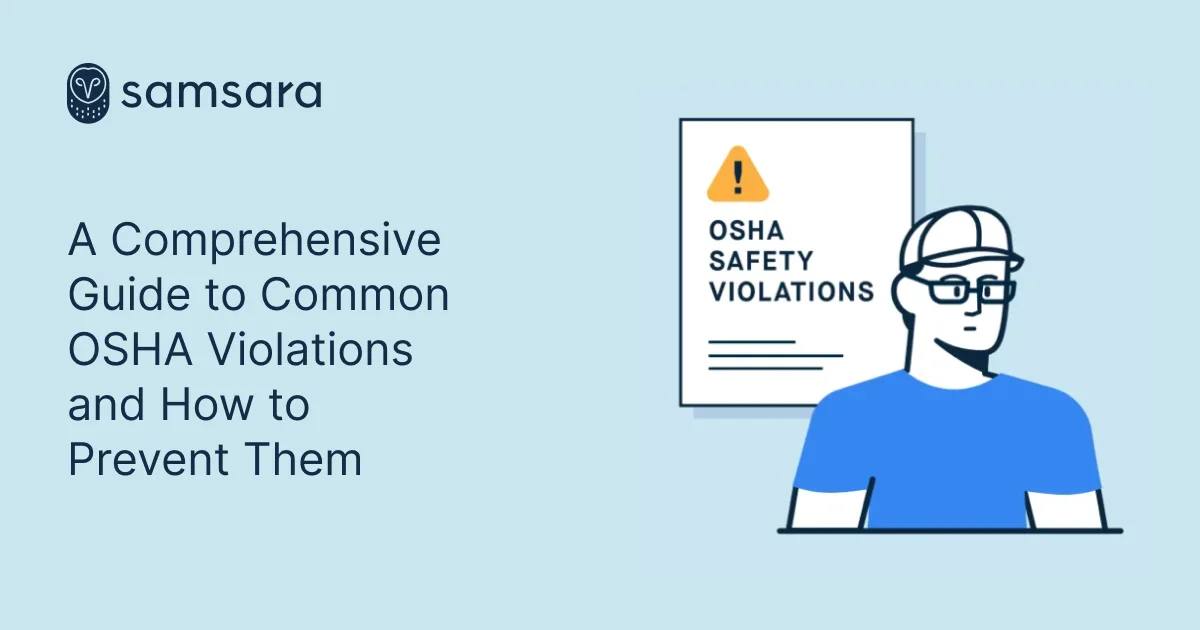A Comprehensive Guide to Common OSHA Violations and How to Prevent Them
May 16, 2024

Get Started
Check Our PricesKey Takeaways
In this guide, we explore how organizations are staying compliant with OSHA standards and enhancing workplace safety by using innovative technology such as digital forms solutions. We break down common OSHA violations and demonstrate how implementing a digital forms solution can help maintain safe worksites.
In today's rapidly evolving workplace, ensuring safety and compliance with Occupational Safety and Health Administration (OSHA) standards is more critical than ever. OSHA issues thousands of violations annually for not meeting health and safety standards. These fines are expensive, starting at around $7,000 and typically exceeding $14,000. Beyond the financial burden, unsafe working conditions may lead to serious injuries or even job sites being completely shut down.
To ensure workplace safety, modern organizations are leveraging innovative technology such as digital forms solutions to streamline manual workflows and improve operational efficiency. This guide breaks down common OSHA violations, and how a digital forms solution can help with keeping worksites safe and compliant.
What is OSHA?
Established by the Occupational Safety and Health Act of 1970, OSHA's primary mission is to ensure safe working conditions for employees in the United States (U.S.). According to the U.S. Department of Labor, federal OSHA requirements extend across a variety of general industry safety hazards, such as equipment handling, protection training, and more. Typically, OSHA inspectors will conduct onsite inspections to check for potential safety violations without any advanced notice, so it’s important to be compliant with OSHA’s general requirements. According to federal law, violations of these standards can lead to major consequences, such as hefty fines and citations.
Common OSHA violations to avoid
When developing a safety protection program to ensure that health standards are met, it’s important for safety managers to be aware of common OSHA violations that might occur. Here are a few general requirements you should be aware of to avoid OSHA citations:
Fall Protection: Fall hazards and falling objects can cause serious physical harm. You can minimize these safety issues by implementing a fall protection system, such as guardrails, fences, safety nets, and personal fall arrest systems.
Hazard Communication: The United Nations defines hazard communication as safety requirements and classifications for the production and transportation of hazardous chemicals. Workers must be educated and trained on the specifications of dealing with chemical hazards, and containers must be clearly labeled.
Respiratory Protection: Adopting a respiratory protection program can mitigate air contamination from dusts, fogs, smokes, mists, gas, vapors, and sprays. You can achieve this by changing the infrastructure of your worksite to minimize confinement and maximize ventilation. You can also provide your employees with respirators to encourage air flow.
Lockout/Tagout (LOTO): Certain machines operate using energy sources like steam, electricity, or chemicals. Without safety precautions, these machines may pose safety risks and can cause workplace injuries. One way to reduce the dangers associated with hazardous energy is with lockout/tagout (LOTO) protocol. This safety procedure involves specifying a machine as “off” after a machine has been locked, then adding a tag that includes details of the person who has the keys to the lock.
Powered industrial trucks: Heavy duty vehicles such as forklifts and tractors are considered powered industrial trucks. These pieces of equipment have highly specific safety requirements such as fire protection, proper usage, and maintenance.
Personal Protective Equipment (PPE): All workers should be provided appropriate equipment to minimize safety hazards. PPE can include gloves, shoes, earplugs, hard hats, respirators, vests, eye and face protection, and more.
Machine Guarding: Heavy machinery such as power saws, jointers, presses, and milling machines can cause debris like sparks or flying chips. Minimize safety issues by providing employees with the necessary PPE. You can also employ machine guarding, which adds physical barriers and safety devices to job sites.
How can digital forms ensure compliance with OSHA standards?
To ensure workplace safety and avoid serious violations, safety managers often use paper-based forms and checklists to conduct inspections. For example, forms such as pre-use equipment inspections, preventive maintenance checklists, and safety audits are often used to ensure OSHA standards and minimize safety issues.
Though forms are critical to safe working conditions and OSHA compliance, paper-based workflows are often inefficient and time-consuming. Safety managers may need to spend hours ensuring employees are completing forms in a timely manner. Similarly, field workers find it hard to remember to fill out the right forms with the relevant information.
Today, advancements in Internet of Things (IoT) technology make it possible to digitize mission-critical forms, transforming the way you collect, manage, and analyze operational data. Traditional paper-based systems are error-prone, inefficient and lack real-time visibility. In contrast, digital forms solutions like Samsara Connected Forms are easy for workers to use, while also enhancing data accuracy and operational efficiency. Some benefits of digital forms include:
Digitizing paperwork: Easily digitize paper-based forms for any site operation, enabling workers to complete them accurately and on the go.
Resolving issues faster: Reduce manual work with pre-populated data from your assets, proactive alerting, and collaborative issue resolution.
Consolidating data: Consolidate operations data in one unified platform and unlock insights to proactively prevent accidents.
If you’re curious about how Samsara can help you pass your OSHA inspections and improve worker safety, reach out for a free demo or trial today.
LEARN MORE